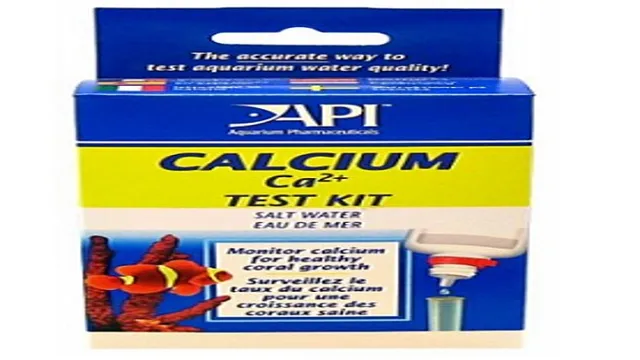How to Check Calcium in Aquarium: A Beginner’s Guide to Calcium Testing

Do you want to ensure that your aquarium is thriving with life? Checking the calcium levels in your aquarium could be the solution you’ve been looking for. Calcium is essential for the growth and development of your aquatic pets, particularly invertebrates such as snails, shrimp, and corals. But how do you check the calcium levels accurately? Don’t worry, we’ve got you covered.
In this blog, we’ll guide you through the process of checking calcium in your aquarium and help you maintain a healthy living environment for your aquatic pets. So grab a cup of coffee, sit back, and let’s dive in.
Why Testing for Calcium is Important
If you’re wondering how to check calcium in your aquarium, it’s important to understand why testing for calcium is essential. Calcium is a fundamental element that is crucial for any aquatic life, particularly corals and other invertebrates. Without proper calcium levels, these organisms will struggle to form and maintain their shells or exoskeletons, leaving them vulnerable to disease and death.
Additionally, inadequate calcium levels can negatively impact the overall health and growth of your other fish and plant life. By regularly testing and monitoring your aquarium’s calcium levels, you can ensure that your aquatic ecosystem is thriving and healthy. One way to check calcium levels is by using a calcium test kit, which will provide you with an accurate reading of your aquarium’s calcium concentration.
By taking these proactive steps, you will help to create a well-balanced and thriving aquatic environment for all of your aquatic creatures to enjoy.
Promotes Healthy Coral Growth
When it comes to maintaining a healthy coral reef, testing for calcium is crucial. Calcium is a vital component for the growth of corals, as it helps them build their outer skeletons. Without adequate levels of calcium, corals can become stunted, discolored, and prone to disease.
That’s why it’s important to regularly test for calcium levels in your aquarium or reef system. By ensuring that calcium levels are within the recommended range, you can help promote healthy coral growth, vibrant colors, and a thriving ecosystem. Just like our bones need calcium to stay strong, corals need it to stay healthy and resilient.
So, don’t overlook the importance of testing for calcium in your aquarium or reef system. Make it a priority, and watch your corals thrive!

Helps Maintain Water Chemistry Balance
If you are a pool owner, you probably already know the importance of maintaining the water chemistry balance. One of the key elements to consider is the calcium level. Testing for calcium is an essential step to ensure that your pool water is healthy and safe for swimming.
But why is calcium so important? Well, firstly, it helps to prevent corrosion of your pool equipment and surfaces, such as tiles and plaster. If the calcium level is too low, it can cause the water to become corrosive and damage your pool structure over time. On the other hand, if the calcium level is too high, it can lead to scaling, which can cause blockages and other issues in your pool’s pipes and filters.
Testing for calcium is also vital for maintaining water hardness, which is crucial for pool comfort. Without the right hardness level, your pool water can become too soft or too hard, leading to potential health hazards and discomfort for swimmers. In conclusion, don’t overlook the importance of testing for calcium when it comes to maintaining your pool water chemistry balance.
It affects not only the appearance of your pool but also the overall health and safety of those using it. So, take the time to regularly test your pool’s calcium level and make the necessary adjustments to keep your pool in top condition.
Types of Calcium Test Kits
When it comes to maintaining a healthy aquarium, checking the calcium levels is crucial. Calcium is an essential part of a reef’s composition and supports the growth of corals and other organisms. There are different types of calcium test kits available, each with its own advantages and disadvantages.
The most common types of calcium test kits include titration kits, colorimetric kits, and electronic meters. Titration kits involve adding reagents to a water sample until it changes color to determine the calcium concentration. Colorimetric kits use a color chart to compare the intensity of the water sample’s color to the colors on the chart to determine calcium levels.
Electronic meters work by measuring the calcium ion concentration in water using a probe. Understanding the different types of calcium test kits available will help you choose the best one for your aquarium and monitor your calcium levels effectively. By regularly checking the calcium levels, you can ensure a healthy environment for your aquatic pets to thrive. (See Also: How to Breed Fish in My Aquarium: A Beginner’s Guide to Successful Reproduction)
Titration Kits
When it comes to testing the calcium levels in your aquarium, using a Titration Kit is a popular and effective method. There are a few different types of calcium test kits available, each with their own benefits and drawbacks. One of the most common is the Salifert Calcium Test Kit, which is known for its accuracy and ease of use.
It works by gradually adding a solution to your water sample, and visually observing when a color change occurs. The results can then be compared to a color chart to determine your calcium levels. Another popular option is the Red Sea Calcium Pro Test Kit, which relies on a digital colorimeter to measure the calcium concentration in your aquarium water.
This method is highly accurate and convenient, but may be more expensive than other test kits on the market. Ultimately, the type of calcium test kit you choose will depend on your personal preferences and needs. Regardless of which option you choose, regularly testing your aquarium’s calcium levels is key to maintaining a healthy and thriving aquatic ecosystem.
Colorimetric Kits
Colorimetric kits are a popular and easy way to test for calcium levels in a variety of applications such as aquaponics, soil testing, and water analysis. There are two main types of calcium test kits: titration-based and colorimetric-based. Titration-based kits involve adding a specific reagent to a sample until it reaches its endpoint, where it changes color to indicate the calcium concentration.
Colorimetric-based kits involve adding a specific reagent to a sample and comparing its color to a color chart to determine the concentration of calcium. Both types of kits are accurate and reliable, but colorimetric-based kits tend to be easier and quicker to use. So, whether you are a novice or experienced user, there is a calcium test kit available for all your needs.
Electronic Testers
Electronic testers are a must-have for any aquarium owner who wants to maintain a healthy and thriving aquatic environment. When it comes to calcium test kits, there are various types available in the market to suit different needs and preferences. One type of calcium test kit is the liquid dropper test kit, which involves adding a few drops of a reagent to a water sample and observing the color change to determine the calcium levels.
Another type is the titration test kit, which works by adding a reagent to the water sample until the color changes, indicating the calcium concentration. The digital electronic tester is another type of calcium tester that is becoming more popular due to its reliability and accuracy. It works by measuring the electrical conductivity of the water, which is then converted into calcium concentration.
With so many options available, it is essential to choose the type of calcium test kit that suits your budget, preferences, and requirements. Investing in a good quality calcium test kit ensures that your aquarium remains healthy and balanced, preventing any unwarranted losses to your aquatic life.
Step-by-Step Guide to Testing Calcium Levels
If you’re a fish enthusiast, it’s essential to check the calcium levels in your aquarium regularly. Calcium is vital for the health and growth of your fish and plants. A simple way to test the calcium levels is by using a test kit.
First, choose a reputable brand of test kit and follow the instructions provided. The testing process usually includes adding a few drops of reagent to a water sample and comparing the color to the chart provided. It’s important to test calcium levels weekly and make adjustments as needed.
Adding calcium supplements or increasing the water hardness can help maintain proper calcium levels. By staying on top of your aquarium’s calcium levels, you can ensure your fish and plants thrive and live healthy lives.
Collect a Water Sample
If you’re looking to test the calcium levels in your water, the first step is to collect a water sample. This may seem like a daunting task, but it’s actually quite simple. Begin by locating your water source, whether it be a well or a tap.
Next, you’ll need to clean a container thoroughly to ensure that no outside materials compromise the sample. Once your container is clean, fill it up with water from your source. It’s important to take note of the location and time of day that you collected the sample, as this information will be useful later.
Bring the sample to a testing facility or use a testing kit to analyze the calcium levels. By starting with a water sample, you are able to accurately assess the calcium levels and make informed decisions about the quality of your water. (See Also: How to Build Levels in Hamster Aquarium: Easy Tips and Tricks)
Add Calcium Reagent to the Sample
Add Calcium Reagent After collecting your water sample and preparing it as stated in the previous steps, it’s now time to add the calcium reagent solution to test the levels of this important mineral. Start by taking the calcium reagent bottle and carefully adding a few drops into the sample using the provided dropper. Be sure to mix the solution thoroughly by swirling the sample gently and avoiding any splashing.
The calcium reagent will react with the calcium present in the water, producing a slight color change. The extent of color change indicates the concentration of calcium in the sample. The test results will vary depending on the type of water you’re testing, so be sure to consult the recommended levels for your specific application.
It’s important to note that calcium levels can affect the taste, appearance, and even the lifespan of pipes and appliances, so it’s crucial to stay on top of calcium levels. With this simple step-by-step guide, you can easily test the calcium levels in your water and adjust accordingly for a healthy and properly functioning water system. So why wait? Add calcium reagent to your water sample now and discover the mineral’s concentration levels.
Follow Kit Instructions to Determine Calcium Level
Testing your pool’s calcium level is an essential part of pool maintenance. High calcium levels can lead to scaling and cloudy water, while low levels can cause corrosion and etching in your pool equipment. Fortunately, determining your pool’s calcium level is a simple process that can be done with a calcium hardness test kit.
First, you will need to follow the instructions provided by the kit to prepare the test solution. Once you have the solution prepared, simply take a water sample from your pool and add the test solution. The kit will provide you with a color-coded chart to compare your water sample to.
Simply match the color of your water sample with the corresponding color on the chart to determine the calcium level in your pool. Remember to test your pool’s calcium level regularly to ensure your pool water stays balanced and healthy for swimming.
Interpreting Results and Taking Action
If you are wondering how to check the calcium levels in your aquarium, there are a few steps you can take to ensure accuracy. First, obtain a high-quality calcium test kit. Follow the instructions carefully, making sure to measure the water temperature and adjust the test accordingly.
Once you have your reading, compare it to the recommended levels for your particular type of aquarium. If the calcium levels are too low, this can affect the health of your aquatic life. To address this issue, options include adding calcium supplements or adjusting the composition of your water with additives that contain calcium.
It is important to take action to correct imbalanced calcium levels in your aquarium so that your fish, plants, and other creatures can thrive. A well-maintained aquarium with proper calcium levels will not only look great but be a healthy environment for your aquatic pets.
Acceptable Calcium Levels
Calcium levels are a crucial part of maintaining good health. It’s vital to look at your results and understand what they mean so you can take action if necessary. The ideal calcium range is between
5 and 2 mg/dL. If your levels are high or low, it’s important not to panic but understand the potential causes and make informed decisions.
Low levels may indicate a calcium deficiency, while high levels may indicate a thyroid or parathyroid issue. Eating a calcium-rich diet, getting enough Vitamin D, and exercising regularly can help keep your levels in the desired range. Don’t hesitate to speak with your doctor if you are concerned about your calcium levels.
Adjusting Calcium Levels if Necessary
When it comes to interpreting your calcium blood test results, it’s important to understand the normal range of calcium levels in the body. Generally, the normal range for total calcium levels is between 5 and (See Also: How to Get Rid of Blanket Weed in My Aquarium: Ultimate Guide for Healthy Water)
2 milligrams per deciliter (mg/dL), but it can vary depending on factors such as age and sex. If your calcium levels fall outside of this range, your doctor may recommend adjusting your calcium intake. Too much or too little calcium can cause health problems, so it’s important to work with your healthcare provider to determine the proper amount of calcium for your individual needs.
Some options for adjusting your calcium intake may include increasing or decreasing your dietary intake of calcium-rich foods or taking calcium supplements. By focusing on interpreting your results and taking appropriate action, you can help keep your calcium levels within a healthy range and maintain good overall health.
Conclusion and Maintenance Tips
In the world of aquariums, checking calcium levels is crucial for maintaining a healthy environment for our aquatic friends. But fear not, checking calcium is a simple process that can be done using various kits available in the market. Just remember, a little bit of calcium is essential for their growth, just like how a little bit of cheese is essential for our own bones.
So, let’s not get too cheesy and keep those aquariums thriving with the right amount of calcium!”
FAQs
Why is it important to check calcium levels in an aquarium?
Checking calcium levels is important because many marine organisms, such as corals and shellfish, require calcium for proper growth and skeletal development.
How often should calcium levels be checked in an aquarium?
Calcium levels should be checked at least once a week in a reef aquarium, and less frequently in non-reef aquariums.
What is the ideal calcium level for a reef aquarium?
The ideal calcium level for a reef aquarium is between 380-450 ppm.
What tools are needed to measure calcium levels in an aquarium?
A calcium test kit, a clean test tube, and a reliable source of freshwater are needed to measure calcium levels in an aquarium.
Can high calcium levels be harmful to aquarium inhabitants?
Yes, high calcium levels can be harmful to aquarium inhabitants and can cause issues such as excessive algae growth, pH fluctuations, and even death in extreme cases.
How can calcium levels be increased in an aquarium?
Calcium levels can be increased in an aquarium by adding calcium-rich supplements or using calcium reactors.
What are some signs of low calcium levels in an aquarium?
Signs of low calcium levels in an aquarium include coral bleaching, slow growth, and weakened skeletal structures in marine organisms.






